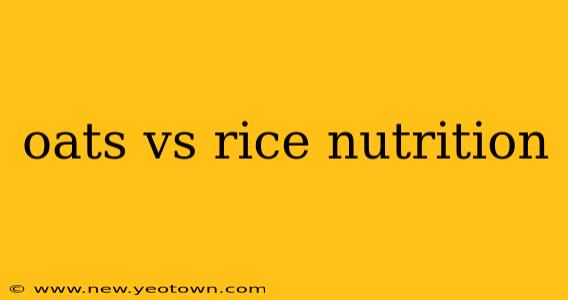Choosing between oats and rice often comes down to personal preference, but understanding their nutritional profiles can significantly impact your dietary choices. This isn't just a simple "which is better?" question; it's about understanding which grain best suits your individual needs and goals. Let's dive into a head-to-head comparison, exploring the nutritional powerhouses that are oats and rice.
Oats: The Hearty Champion
Imagine a chilly morning. The aroma of warm oatmeal fills the air, a comforting hug in a bowl. Oats, those humble grains, are nutritional powerhouses. Their starchy goodness is packed with fiber, vitamins, and minerals. Rolled oats, steel-cut oats, and quick oats all offer slightly different textures and cooking times, but their nutritional benefits remain remarkably consistent.
Nutritional Highlights of Oats:
- Fiber Superstar: Oats are exceptionally high in fiber, both soluble and insoluble. Soluble fiber helps lower cholesterol, while insoluble fiber promotes healthy digestion. This high fiber content contributes to feelings of fullness, making them a great choice for weight management.
- Nutrient-Rich: Oats are a good source of manganese, magnesium, phosphorus, and selenium. They also contain B vitamins, crucial for energy production and overall well-being.
- Beta-Glucan Benefits: The soluble fiber beta-glucan in oats is linked to improved heart health, blood sugar control, and even immune function.
Rice: The Versatile Grain
Rice, a staple food in countless cultures, offers its own set of nutritional benefits, varying greatly depending on the type. From fluffy white rice to hearty brown rice, the options are vast.
Nutritional Highlights of Rice:
- Carbohydrate Source: Rice is primarily a carbohydrate source, providing energy. White rice is more refined and contains less fiber and nutrients than its brown counterpart.
- Brown Rice's Nutritional Edge: Brown rice, the less-processed version, boasts significantly more fiber, magnesium, manganese, and selenium compared to white rice. It’s a better choice for maintaining healthy blood sugar levels and promoting digestive health.
- Variety is Key: Different types of rice – basmati, jasmine, wild rice – offer slight variations in nutrient profiles, but brown rice consistently emerges as the nutritional winner.
Oats vs. Rice: A Side-by-Side Comparison
| Feature | Oats | Brown Rice | White Rice |
|---|---|---|---|
| Fiber | High (both soluble & insoluble) | Moderate | Low |
| Protein | Moderate | Moderate | Low |
| Vitamins & Minerals | Good source of several (B vitamins, Manganese, Magnesium) | Good source of several (Magnesium, Manganese, Selenium) | Lower in vitamins and minerals |
| Glycemic Index | Moderate to Low (depending on type) | Moderate | High |
| Digestibility | Generally easy to digest | Can be slightly more challenging | Easy to digest |
Which Grain Reigns Supreme?
There’s no single "winner" in the oats vs. rice debate. The best choice depends on your individual dietary needs and preferences.
- For optimal fiber, nutrients, and heart health: Oats often take the lead.
- For a quick energy boost and easy digestibility: White rice might be preferable, but bear in mind the lower nutritional value.
- For a balanced approach with decent fiber and nutrients: Brown rice offers a solid middle ground.
Frequently Asked Questions (FAQs)
Are oats better for weight loss than rice?
Oats generally promote better weight management due to their higher fiber content, leading to increased satiety and potentially aiding in calorie control. Brown rice is a healthier choice than white rice in this regard.
Which is better for diabetics?
Oats, particularly due to their soluble fiber content, and brown rice, with its moderate glycemic index, are generally better choices for managing blood sugar levels compared to white rice.
What are the differences in cooking times?
Oats have variable cooking times, with quick oats requiring only a few minutes, while steel-cut oats need longer cooking times. Rice cooking times also vary depending on the type, with white rice generally cooking faster than brown rice.
Can I eat oats and rice together?
Absolutely! Combining oats and rice in a meal can offer a diverse range of nutrients and create a balanced and satisfying dish.
In conclusion, the choice between oats and rice depends on your individual needs and preferences. Both grains offer valuable contributions to a healthy diet, each with its own set of nutritional strengths. Remember to choose whole grains whenever possible to maximize their benefits.

